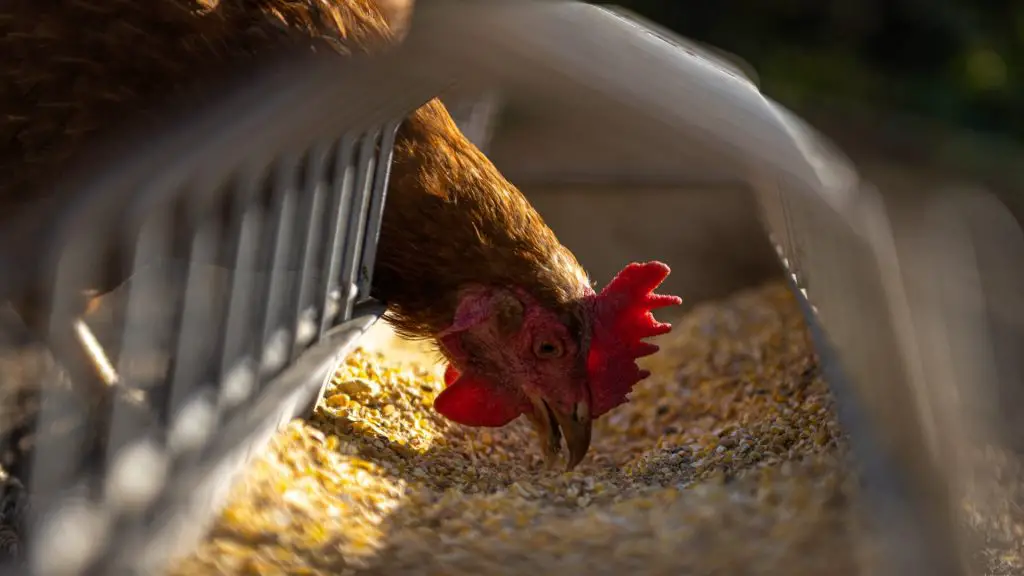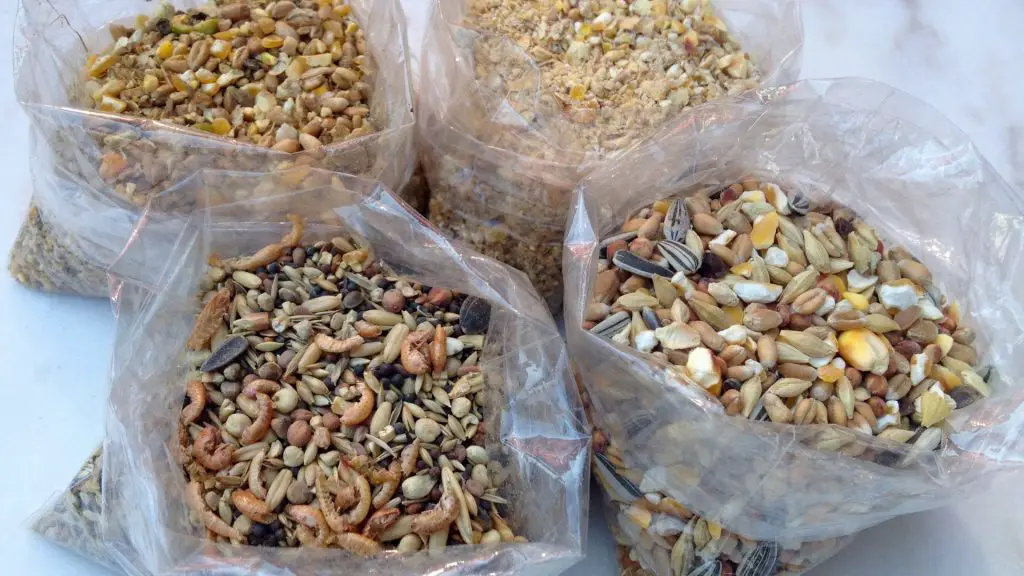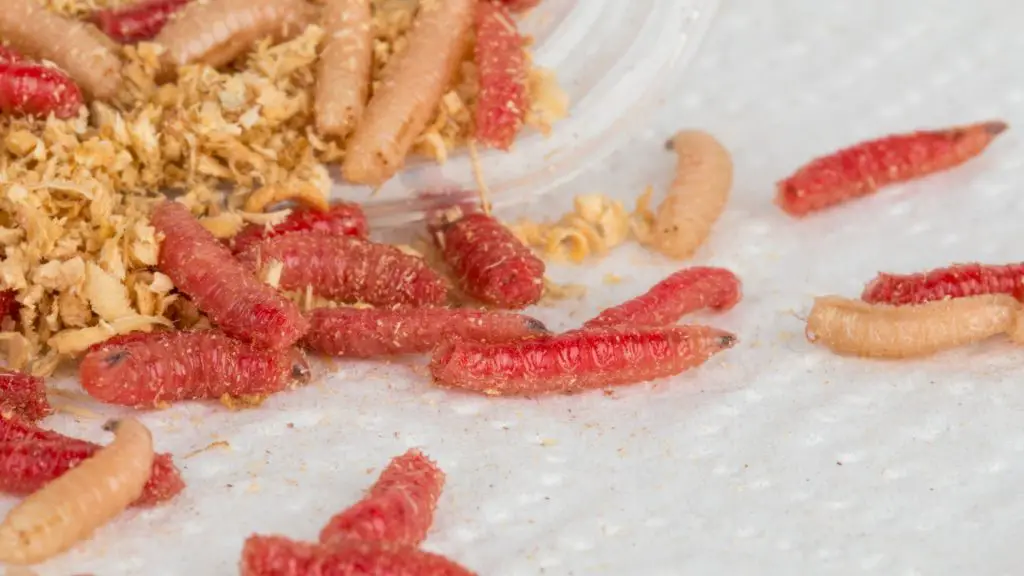If you are new to raising chickens, you may be confused by all the types of feed available for poultry. Your chickens’ feeding requirements differ between development stages and what kind of chickens you are raising. So, you might be wondering what your chicken needs to thrive.
What should you consider in choosing a chicken feed? Chicken feed should take into account the correct levels of fats, protein, minerals, and vitamins suited to the age and type of your chicken. Water is one of the essential parts of your chicken feeding program. Always match the commercial feed type to the stage of your chickens’ development.
Whether you wish to keep chickens in the backyard as valuable egg suppliers or start farming chicken for profit, nutrition is essential. Understanding the nutritional needs of your particular poultry is the first step in choosing the suitable feed.
If you want to know all about what makes a balanced diet for your feathered flock, please read on.
What Is in Chicken Feed?

The ingredients in the chicken feed are formulated to provide necessary carbohydrates, fats, proteins, minerals, and vitamins that chickens need to be healthy.
Commercial chicken grains offer various feed types to suit the particular needs of different chickens at the various stages of their development.
Related: What to Feed Backyard Chickens? | Information and Facts
Carbohydrates
Carbohydrates are essential to poultry nutrition as they provide energy for the body and influence functions such as body temperature. Chicken carbohydrate requirements vary from season to season and according to their age and purpose.
During the winter months, chicken farmers usually increase their carbohydrate feeding level since chickens require more carbohydrates to maintain their body temperature.
Typically, chicken farmers source their carbohydrates from a selection of grains such as:
- Sorghum
- Wheat
- Oats
- Quinoa
- Barley
- Corn
Carbohydrates make up the most significant part of your poultry diet and contain digestible components such as starch and non-digestible components such as cellulose. These usually fall under the banner of crude fiber and have a role in your chicken’s digestive health in appropriate quantities. Too much crude fiber may affect your chicken’s nutrient absorption and health.
Fats
Fats are an essential part of your poultry diet and provide some of the highest energy sources for your chickens. This enhances the dispersion of micronutrients in feed and allows poultry to absorb fat-soluble vitamins such as A, D, E, and K.
Additionally, this also enables smooth passage of foodstuff through the digestive tract and reduces grain dust.
Common sources of fat for poultry include:
- Vegetable oil
- Tallow
- Blended fat products
Fatty acids are responsible for hormone synthesis, and poultry specifically requires linoleic acid because chickens cannot generate this fatty acid on their own or from other nutrients.
Particularly vital sources of linoleic acid are oils such as:
- Corn oil
- Sunflower oil
- Safflower oil
Protein
Proteins provide your poultry with essential amino acids. After digestion, protein breaks down into these amino acids. These acids are then absorbed into the blood and transported to cells that transform into the proteins the chicken needs. Proteins are necessary for the growth of muscles, nerves, cartilage, and skin and are essential for healthy development.
There are typically 22 amino acids in nutritionally balanced chicken feed, 11 of which are essential for your chicken’s health. No one source of protein is sufficient to provide all the amino acids your poultry require.
The primary sources of protein in chicken feed include:
- Fish meal
- Meat and bone meal
- Soybean meal
- Cottonseed meal
- Corn gluten meal
Minerals
The mineral component of your poultry diet, often known as ash content, is made up of inorganic matter. These are essential for building strong bones and also aid in shell formation in laying chickens. It also assists the metabolic functions and electrolyte balance and is required in trace amounts in your chicken feed.
The most important minerals for bone formation are:
- Calcium
- Phosphorous
- Magnesium
Sources include limestone, oyster shell, or meat and bone meal.
For Electrolyte balance:
- Sodium
- Potassium
- Chlorine
Sources include dicalcium phosphate, meat, and bone meal.
Trace minerals for chemical reactions:
- Manganese
- Iodine
- Zinc
- Selenium
- Copper
You may source these in supplement form for chicken feed.
Vitamins
Vitamins are essential for poultry health, much as they are essential for humans. It affects growth and reproduction. Deficiencies in vitamins can cause disease and impact egg yield and poultry development.
Even in trace amounts, the vital vitamins in chickens include:
- Vitamin A (vision and reproduction)
- Vitamin D (strong bones, growth, calcium absorption)
- Vitamin E (antioxidant)
- Vitamin K (blood clotting)
- B-Complex (metabolism)
The vitamin components may vary from premix feed to feed; you may consider a vitamin premix in your poultry diet to ensure the full spectrum.
What Is Chicken Feed Called?

Chicken feed is labeled differently depending on the age and breed of the chicken. Options are sold as starter feed, grower feed, finisher feed, and layer food. It’s important to provide the proper feed for your chickens to ensure they receive the necessary nutrients.
One of the most serious mistakes you may make as a chicken breeder is to feed your chickens the incorrect type of feed.
For instance, if you feed starter food meant for chicks to a young broiler, the broiler may suffer developmental abnormalities in their legs or even death as a consequence. Just as in humans, baby chicks need a very different diet from teenagers and adults.
Here are the four main types of chicken feed according to age and breed:
Starter Feed (Birth to 18 Weeks)
Commercial manufacturers formulate starter feed to provide nutrition to newly hatched chicks of four to six weeks, and the feed suits their high energy and rapid growth. It is typically high in protein and contains high calcium levels for bone growth.
Often these foods contain amprolium, a medication for the parasitic condition of coccidiosis, which is often fatal in chicks.
Related: What Do Baby Chicks Eat? | Information and Facts
Grower Feed (5–20 Weeks Pullet, 4–5 Weeks Broiler)
Grower feed has protein levels ranging from 17-20% and suits the chicken nutritional requirements between the chick and adult chicken stage. The calcium levels are lower than the starter feed, as this level requires less than chicks.
This feed comes in highly digestible form to optimize growth in boilers and chicken’s body weight for future egg-laying.
Finisher Feed (5–6 Weeks Broiler)
Finisher feed has more significant levels of fats and around 18% protein for the larger and more active broilers between childhood and adulthood.
Broilers develop fast, and this type of feed maximizes growth for meat production when the chicken is just seven to nine weeks old. They are genetically bred to deliver maximum meat yields at the earliest age.
Layer Food (Chickens 22 Weeks and Up)
Layer food suits laying chickens after they lay their first eggs. The increased calcium levels help build strong eggshells and enhance chickens’ laying capacity.
One should not give this food to non-laying chickens as the elevated calcium levels may cause damage. This layer feed contains around 18% protein and comes in either mash or pellet form for easy digestion.
Does Chicken Feed Affect Eggs?
Chicken feed does affect eggs in taste, appearance, and nutrition. A chicken’s diet must be well-balanced to support optimal egg production.
In general, the more nutritious and healthier the chicken feed is, the better tasting and healthier the eggs will be.
How to Ferment Chicken Feed?
To ferment your chicken feed, simply soak your grains, seeds, and legumes in chemical-free water overnight, ensuring the feed is properly submerged. You could add cultures such as sauerkraut or water kefir to speed up the process.
Scientific studies suggest that fermented chicken feed improves gastrointestinal microecology, health, and performance.
In this study, fermented feeds showed a higher level of lactic acid bacteria and organic acids that play a vital role in a chicken’s gut health. Fermentation of grain and nuts reduces the grain’s natural protective coatings to release more nutrients and enzymes for the chicken to absorb.
How Much Diatomaceous Earth Is in Chicken Feed?
According to a scientific study, Diatomaceous Earth (DE) supplemented at 2% of the chicken feed was sufficient to reduce parasites and improve egg production in free-range layer chickens. The DE group of chickens showed larger eggs with more yolk and a reduced number of mites.
DE has been shown to reduce the worm burden in poultry as well as reduce mites and improve egg size and yolks in clinical trials. It is a natural product of fossilized ancient shelled creatures that benefit both humans and poultry.
You may use 2% Diatomaceous earth as a dietary supplement, as a dust bath, and applied directly to your chickens as dust under the wings and vent areas to prevent mites and lice.
- Natural Product - Composed of 2lbs of 100% ground freshwater...
- OMRI Listed - Listed with the Organic Minerals Research...
- Powder Duster Included - Powder duster in the bag for easy and...
- Supports a Great Cause - Harris donates 10% of profits to support...
- Made in the USA – Mined in Nevada and packaged in Georgia
How to Make Chicken Feed Pellets?

You may make your chicken feed pellets by combining a premix with crushed whole grains and feeding it through a feed pellet mill machine. Commercial pellets are a mash held with a binder and heat-treated cut into various lengths and diameters.
How to Grow Maggots for Chicken Feed?

You may create your maggot farm for chicken feed by adapting a container with an exit pipe and an inner pipe that ramps from the bottom of your container to the exit. Populate with soldier fly maggots and feed with table scraps and manure.
Scientific studies show that maggots are a good source of protein for organic poultry and a great alternative to fish meal in organic poultry. Live maggots provided better poultry growth and less fear in the maggot-eating poultry.
How to Make a Maggot Farm?
Step 1: Choose a bucket with a 1″ (2.54 cm) uniseal exit pipe.
Step 2: Install a ramp around the inside of the container to the exit pipe at the top of the ramp.
Step 3: Fill the container with waste like kitchen scraps without meat or greens and manure.
Step 4: Collect soldier fly maggots from an existing compost pile and place them in a container.
Step 5: Keep the pile warm by leaving it in a warm area or wrapping the container with insulation.
Step 6: Harvest the maggots through the exit pipe of your container.
What Is the Best Organic Chicken Feed?
The best organic chicken feed will be an organic option that is free of GMOs and nutritionally balanced. Options that are available raw or with minimal processing are also the preferred choice for most chicken owners.
Scratch and Peck Naturally Free Organic Feed
- Boosts Growth and Vitality - Packed with 16% protein from organic...
- Pure Organic Nutrition - Give your flock a healthier choice with...
- Versatile Feeding Options - Choose what’s best! Feed dry for...
- Eco-Friendly Packaging - Comes in recyclable and compostable...
- Grown and Milled in North America - Our feed is proudly sourced...
The Scratch and Peck Organic chicken feed on Amazon is USDA certified organic and GMO-free for optimal poultry health. It contains no soy or corn and is in a raw and natural form without pelletization and unhealthy processing, which makes it perfect for home fermentation.
Purina Organic Layer Crumbles Chicken Feed (Best Layer Feed)
- Certified USDA Organic - Fulfills USDA requirements to guarantee...
- Includes Oyster Strong System - Large-particle calcium breaks...
- 16% protein, 3.25% calcium - Maintains hen health and supports...
- Provides essential amino acids, vitamins and minerals - To help...
- Rich in antioxidants - Supports immune and digestive health
This layer feed on Amazon is USDA Certified organic and free of GMOs. The feed is calcium-enriched with 16% protein for strong eggs and consistent laying. It is also rich in antioxidants and the minerals and vitamins that suit laying chickens’ specific nutritional requirements.
List of Sources
Nutrition for the Backyard Flock
Maggots Are a Good Source of Protein for Organic Poultry
Principles of Feeding Small Flocks of Chickens at Home
Nutrition and Metabolism in Poultry: Role of Lipids in Early Diet



